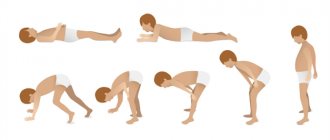Ordinary people call them outcasts or homeless people. Psychologists use the terminology “marginal”. You should understand the meaning of this word, since it is not so narrow and unambiguous. Having considered examples of marginalized people, we can identify types, which is what the online magazine psytheater.com will do.
Public propaganda is the desire for implementation. Each person achieves certain successes that allow him to maintain an average social level. Having a home, family, money, friends, work and other available attributes indicates that a person is socially healthy. However, a category of people that is separated from society is considered separately. They are called marginalized. In other words, they can be called homeless. However, not only this part of people can be called marginal.
If we consider this concept more fully, we can note that some of your friends may be called marginalized.
Who is a marginalized person - definition
According to the sociological explanatory dictionary, a marginal personality is a person who is in a borderline state between two or more social groups, systems, and cultures. What does it mean, a marginal person is an asocial subject, but not necessarily dysfunctional, immoral or suffering from pathological attachments. It is believed that the first marginalized were people freed from slavery who left their usual environment, but were not able to immediately become full-fledged members of society.
If the marginalized in society do not perform socially useful functions, then they create various problems. Marginalized people are capable of forming groups and causing unrest. In European countries, such a phenomenon as a migrant revolt is not uncommon. These people, who were accepted into a foreign country, provided with housing and food, can bring many problems to law-abiding indigenous residents. Somewhat less common are harmless marginals, as examples can be given to representatives of national minorities, the fashionable downshifter movement, etc.
The status of “marginal” can be prescribed to a person by society or accepted by the individual independently. “Stigmatization” and “labeling” of non-standard people can happen in the workplace, in a hospital, at school. Minorities – national, sexual, etc. – are often subjected to this kind of repression. This is a violation of human rights. An individual can realize his own marginality himself. In this case, he must decide whether to “return to normality” or live with the status of “marginal.”
Who are the marginalized and lumpen?
The term “lumpen” was introduced by K. Marx; he included tramps, beggars, and bandits to this group. According to ordinary people, the lumpen and the marginalized represent one group of people with similar interests and lifestyle. This is not entirely true. Lumpen is a declassed, physically and morally degraded element, the “dregs of society”, which is part of a marginal group, but at the same time, a marginal person is not always a lumpen.
Marginal personality according to Robert Park
American sociologist Robert Park considered the following to be the main character traits and personality traits of marginalized people:
- anxiety;
- aggressiveness;
- ambition;
- touchiness;
- selfishness;
- categorical views;
- negativism;
- unsatisfied ambition;
- anxiety states and phobias.
In society, marginalized individuals were people with an asocial lifestyle (poor refugees, homeless people, beggars, tramps, people with various kinds of addictions, lawbreakers), who can be classified as representatives of the social bottom. Their living conditions have a significant negative impact on their mental state. Any civilized society lives according to its own established rules, customs and norms. R. Park believed that a marginal personality
:
- Rejects any norms and traditions accepted in society.
- Has no sense of duty towards the society in which he lives.
- Experiences a strong need to be alone and avoids the company of people.
Important
! Most sociological experts and practicing psychologists believe that the margins are a source of cultural growth. He can objectively, without external influence, evaluate any phenomenon and situation, because he is not involved in it, as if isolated. It fills a social group with new ideas, views, introduces new trends, helps members of society to develop, broaden their horizons, look at problems from a different perspective, and instills tolerance.
Signs of marginalized people
Sociologists call the main feature of the marginalized the severance of economic, social and spiritual ties that exist in “pre-marginal” life. Mostly migrants and refugees become marginalized. A former military man who has been discharged from service but has not yet found himself in civilian society may find himself on the edge of social groups. Connections with the past were severed upon dismissal, but there are still no new ones, and in particularly unfavorable conditions there won’t be any. Then a person can declassify – i.e. sink to the very “bottom” of life.
Other signs of marginality:
- mobility - occurs in the absence of housing, attachments;
- mental problems - appear as a result of the inability to find one’s “place in the sun”;
- development of one’s own values, sometimes hostility towards the existing society;
- sufficient ease of involvement in illegal activities.
Modern definition
To understand the modern understanding of marginality, it is worth turning to the origins of the term. The word marginal itself comes from a Latin word. It is margo, which means edge, and marginalis means extreme. In accordance with this, we can say that the meaning of such a term implies the designation of a person living in a certain social environment, but not sharing it:
- lifestyle;
- values;
- principles;
- moral ideals;
- normal;
- worldview.
That is, marginal is asocial. The one who chose a position on the edge of the system or found himself in it against his will.
Karl Marx gave his definition of this concept. He applied this meaning to people from the lower strata of society. But he called them lumpen.
Important! So, the lumpen are now called marginalized, which is fundamentally wrong, judging by the original meaning of the terms!
In general, over time, these two concepts grew together, although initially they denoted very different social groups. We will humbly follow the crowd and continue to call the lumpen marginals, as the majority is doing now.
Types of marginalized people
With positive developments in events, a person’s period of marginality does not last too long - having adapted, found a job, and joined society, he loses his marginal status. The exception is people who were forced to become marginalized (refugees) or those who consciously chose this way of life (vagrants, radicals, extremists, revolutionaries). Sociologists divide the main types of marginalized people this way: political, ethical, religious, social, economic, biological.
Political marginals
To understand who a political marginal is and the meaning of this term, we can recall the period of Fidel Castro coming to power in Cuba, accompanied by bloody repressions. The “Island of Freedom” became unbearable for the life of about 2 million people who fled to other countries, essentially becoming political marginals - people who are not satisfied with the existing political regime and its laws.
Ethnic marginalized
People who are affected by ethnic marginality usually include individuals born from representatives of different nationalities. Not every interethnic marriage gives rise to marginalized people; this only happens if the child does not associate himself with any of the nationalities of his parents - in this case, he is not accepted anywhere. Another answer to the question who are ethnic marginalized people is national minorities, representatives of extremely small nationalities living among other nationalities.
Religious fringes
The majority of people in society either adhere to a certain religion or do not believe in God at all. Religious fringes are individuals who believe in the existence of a higher power, but cannot call themselves representatives of any existing religion. Among such individuals (prophets) you can find those who gathered like-minded people and created their own church.
Social marginals
Such a phenomenon as social marginality develops in a society experiencing cataclysms: coups, revolutions, etc. Entire groups of people in a changing society are losing their place and cannot find it in the new system. Such social outcasts often become migrants; as an example, we can recall representatives of the nobility who left Russia after the 1917 revolution.
Marginal economic
The answer to the question of who the economic marginal is basically comes down to unemployment and the poverty that accompanies this phenomenon. Economic marginalized people are forced or intentionally losing the opportunity to earn money and live at the expense of others - receiving help from others, benefits from the state, alms, etc. In modern society, super-rich people who are also cut off from society are also considered to be economically marginalized.
Biomarginals
An ideal public organization implies caring for those who find themselves in a difficult situation due to health problems, so the question of who is a biological marginal should not arise. In fact, those who have no value to society due to ill health are left completely unprotected. Biomarginal people include disabled people, chronically ill people, old people, HIV-infected people, children with Down syndrome, etc.
A classic example of a marginalized person is Jeffrey Lebowski, the hero of the cult film “The Big Lebowski” (1998)
If you want to fully understand this topic, I recommend watching the famous cult film by the Coen brothers “The Big Lebowski” (1998). The main character of this film is a classic misfit. Everyone's favorite pacifist Jeffrey Lebowski can be called a classic fringe of the modern world.
Here is the official trailer for The Big Lebowski (1998):
I wish everyone strives to be themselves, stay true to their dreams and not squeeze themselves into the framework of society’s stereotypes, while, of course, not violating the freedom of other people!
See you again on the blog pages!
05/06/2018 74 488 2 Igor
Psychology and Society
Often on television or in the media we hear and see the foreign word “marginal”. Its meaning has undergone significant changes, from the time it was formulated by the American sociologist R. Park to the present day. To explain the current meaning of this concept in simple words, it is necessary to trace the history of the use of this term and highlight the main types of marginalized people in the history of mankind.
Content:
Pros and cons of marginality
The initially negative meaning of the term “marginal” has already changed and does not always carry a negative load. Being outside the “herd”, being different from many is fashionable and even prestigious, but the positive aspects of marginality can be found even in the classical meaning of this phenomenon:
- marginalized people are more mobile than ordinary people; it is easier for them to move to an economically more prosperous area, find a better-paid job, or change their profession;
- due to their dissimilarity with other members of society, some marginalized people can build their own business on this, for example, an ethnic marginalized person can open a store with goods produced by his people;
- Thanks to their flexibility, marginalized people often bring something new and progressive to society.
The negative aspects of marginality include the fact that this phenomenon is mainly associated with radical changes in the structure of society - reforms, revolutions. In general, society always suffers from such changes - the state becomes poorer, promising individuals leave it. Another disadvantage of the marginalization of society is the decline in living standards and security due to the lumpenization of a large number of marginalized people.
Marginality is also negative when it is artificially created. During long-term revolutions and wars, the number of marginalized people grows exponentially, as a result, innocent people die and sink to the bottom. Examples of forced marginalization are the Holocaust of the Jewish nation perpetrated by Nazi Germany and Stalin’s repressions, as a result of which hundreds of thousands of people were exiled, resettled, deprived of work and housing.
Marginality and poverty
Since in modern society the answer to the question of who the marginalized are has changed greatly, the consequences of marginality are not always poverty, deprivation of liberty or even life. Marginal people, as already mentioned, can also be very rich people who, due to their wealth, are freer than other members of society. And there are often cases when successful businessmen retire and leave big cities for the provinces and villages.
Within the framework of such a phenomenon as marginality, it is worth mentioning the recently appeared downshifters. From birth, an individual develops in two opposite directions - as a social person and as an individual person. Ideally, these forces should be balanced, but in reality, one of these directions often outweighs. With increased socialization, a conformist is born, and with increased individualization, a downshifter can be born.
A downshifter is a person who has chosen to live outside of society or has severely limited communication with people outside his family. This is a marginalized person who is quite satisfied with being in a borderline state, when he is free to move around the world and live completely independently. Most often, downshifters prefer to engage in art - drawing, writing books, etc. And their creativity is almost always in demand, because... The author has strong energy and innovative thinking.











